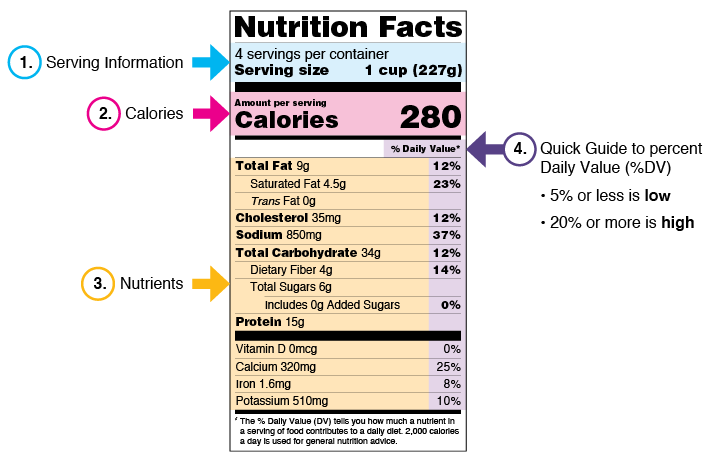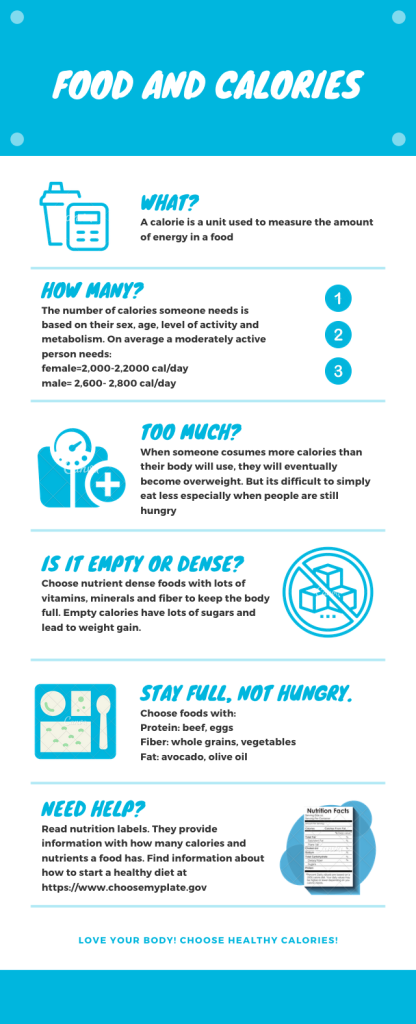2
Laurie Barton
What are Calories?
Calories are in everything people consume, whether it’s a drink, snack, or meal. So what is a calorie? A calorie is a unit used to measure energy. The more calories something has, the more energy it provides for the body. The body uses this energy to move around, keep the heart beating, exercise, and more, so it is important to get enough calories (National Health Service, 2019).
How Many Calories Should Someone Eat?
In order for someone to maintain a particular weight, they must eat the same amount of calories that they spend. Each person requires a particular amount of calories each day based on their sex, age, level of activity and metabolism. On average, it is recommended that a moderately active male consumes 2,600- 2,800 calories per day and female consumes 2,000-2,2000 calories per day. However, if someone chooses to eat more calories than their body will use, they end up storing this extra energy as fat. Having too much extra fat in one’s body makes them at higher risk for chronic diseases and other health problems, which is further explained in chapter 8 (National Health Service, 2019).
All packaged food is required to label how many calories it has per serving. This helps people to be more aware of how many calories and nutrients they are consuming.

In a total of 60 studies, it was found that people ate less calories on a regular basis when paying attention to food labels. In addition they found that food labeling decreases people’s intake of bad nutrients, such as added sugars and trans fats, and increased the consumption of good nutrients, such as fiber and protein (Shangguan et al., 2018).
Notice that the amount of calories per serving is listed at the top, and then basic nutrients such as fiber, protein, and fat, are listed in the Nutrition Facts label. For more information on how to read and use Nutrition Labels for a balanced diet visit: https://www.fda.gov/food/new-nutrition-facts-label/how-understand-and-use-nutrition-facts-label
Why Does It Matter Where People Get Their Calories From?
In order to lose weight, most diets encourage eating a very low amount of calories. But by cutting back on calories, people tend to be extremely hungry and cannot maintain this. So how can someone eat the right amount of calories without being miserable? People need to choose their calories from the right foods.
Even though all calories are essentially the same, they can affect people’s bodies in different ways. For example if you gave one person a Snickers and another person two apples, they would both be consuming about two hundred calories. However, the person with apples would be much more full. And why is this? Apples contain lots of fiber and nutrients which keeps the body feeling full, without the extra unwanted sugar and carbohydrates.
<img class="wp-image-28" title=""Snickers vs Apple" by Laurie Barton is in the Public Domain, CC0” src=”https://pressbooks.pub/app/uploads/sites/4143/2020/03/Screen-Shot-2020-03-13-at-3.43.54-AM-1024×251.png” alt=”Snickers vs. Apples” width=”666″ height=”163″> “Broken Snickers” by Evan-Amos is in the Public Domain and “Apple” is in the Public Domain, CCO
Calorie Dense vs Nutrient Dense
Calorie dense foods tend to have empty calories and leave people feeling hungry. Empty calories are found in foods and drinks that contain little to no nutritional value to the body and tend to have a lot of calories. This is a problem since the body is not getting what it needs, storing the additional empty calories as fat.
Nutrient-dense foods or drinks have lots of nutrients, such as vitamins and minerals, and are low in added sugars and empty calories. Nutrients are necessary for people’s bodies to function efficiently. They help build up and maintain the body by healing wounds, building muscle, and boosting the immune system (Sadler, 2014). Examples of nutrient-dense foods are fruits, vegetables, eggs, and sweet potatoes.
What are Foods That Will Keep Someone Full?
One of the main ways the body regulates how much food it needs is with the feeling of fullness in the stomach. This feeling of fullness is called satiety. Foods that are high in protein and fat increase satiety. In a study recorded by the British Journal of Nutrition, people were less hungry when they ate a diet with high protein and fat. The other group that ate higher carbohydrates and less protein and fat were more hungry. If hunger is decreased and satiety is increased, it prevents people from overeating and helps them stay at a healthy weight. Some foods with high protein and fats are meats, dairy, and nuts (Veldhorst et al., 2010).
Foods with high fiber also keep the body full longer, since it remains in the body longer. In many different studies, it is shown that diets high in fiber are associated with lower body weight. People with a high fiber diet, compared to a low fiber diet, reported 39% lower in hunger and 22% lower in food intake. Good sources of fiber include grains such as rye bran and kernel fiber, and legumes such as black beans and peas (Clark & Slavin, 2013).
For more help on choosing a filling, nutrient-dense diet visit: https://www.choosemyplate.gov
Thermal Effect of Food
The energy, or calories, it takes to digest, absorb, and metabolize nutrients is the thermal effect of food (TEF). For example, after eating a meal, about 10% of the calories consumed are used by the body to digest and distribute the nutrients from the meal (Waehner, 2019). Some foods and drinks require a lot of energy in order to break them down into usable calories. Protein has a high TEF, using about 20-35% of its calories in order to break down into usable nutrients. Eating food with a high TEF can further increase the body’s metabolism and are helpful for weight loss. Some examples of foods and drinks that increase the thermal effect of food are fish, protein, and coffee (Petre, 2019).
Foods Can Make People More Hungry?
On the other hand, there are foods and drinks that can decrease a person’s metabolism and sometimes even increase their hunger. Foods with refined sugars, such as fructose, are shown to increase hunger after eating them. It was discovered that fructose increases hunger and food intake as well as decreasing metabolism. This shows that eating foods with added sugars such as pastries, cookies, and desserts can make it even more difficult to eat less and stay full (Page et al., 2013). With this increased hunger people tend to eat extra food that their body does not need.
Summary
People need the right amount of calories to have the energy to move around and live life. Good sources of calories, such as foods with protein, fiber, and fats, can provide filling calories. However, foods that have refined sugars and are processed can make people overeat and become more hungry. It is important for each person to know how many and what type of calories they eat in order for them to lead a healthy life. Please see the infographic below for a summary of Food and Calories.

Review Questions
References
Clark, M. and Slavin, J. (2013). The effect of fiber on satiety and food intake: a systematic review. J AM Coll Nutr, 32(3), 200-211. doi: 10.1080/07315724.2013.791194.
Harvard T.H. Chan. (2020). Food and diet. School of Public Health. https://www.hsph.harvard.edu/obesity-prevention-source/obesity-causes/diet-and-weight/
Merriam-Webster. (n.d.). Nutrient. In Merriam-Webster.com dictionary. https://www.merriamwebster.com/dictionary/nutrient
National Health Service. (2019). Understanding calories. https://www.nhs.uk/live-well/healthy-weight/understanding-calories/
Osilla, Eva. & Sharma, S. (2019). Calories. StatPearls. [eBook addition]. https://www.ncbi.nlm.nih.gov/books/NBK499909/
Page, K., Chan, O., Arora, J., Belfor-Deaguiar, R., Dzuira J., Roehmholdt, B., … Cline G. (2013). Effects of fructose vs glucose on regional cerebral blood flow in brain regions involved with appetite and reward pathways. Jama, 309(17), 1773. doi: 10.1001/jama.2012.116975.
Petre, A. (2019). Does ‘calories in vs. calories out’ really matter. Healthline. https://www.healthline.com/nutrition/calories-in-calories-out#beyond-the-model%E2%80%99
Sadler, B. (2014). Is your food energy dense or just empty calories? Michigan State University. https://www.canr.msu.edu/news/is_your_food_nutrient_dense_or_just_empty_calories
Shangguan, S., Afshin, A., Shulkin, M., Ma, Wenjie., Marsden, D., Smith, J., … Mozzaffarian, D. (2018). A meta-analysis of food labeling effects on consumer diet behaviors and industry practices. Review Article, 56(2), 300-314. https://doi.org/10.1016/j.amepre.2018.09.024.
Veldhorst, M., Westerterp, K., Vught, A., & Westerterp-Platenga, M. (2010). Presence or absence of carbohydrates and the proportion of fat in a high-protein diet affect appetite suppression but not energy expenditure in normal-weight human subjects fed in energy balance. British Journal of Nutrition, 104, 1395-1405. doi:10.1017/S0007114510002060.
Waehner, P. (2019). How to calculate the thermic effect of food. Verywellfit. https://www.verywellfit.com/thermic-effect-of-food-1231350
an amount of food having an energy-producing value of one large calorie
usable power
continuing or occurring again and again for a long time
calories from food that supply energy but have little or no nutritional value
the total nitrogenous material in plant or animal substances
any of various compounds of carbon, hydrogen, and oxygen that are glycerides of fatty acids, are the chief constituents of plant and animal fat, are a major class of energy-rich food, and are soluble in organic solvents but not in water
any of various neutral compounds of carbon, hydrogen, and oxygen (such as sugars, starches, and celluloses) most of which are formed by green plants and which constitute a major class of animal foods
mostly indigestible material in food (such as legumes, whole grains, and vegetables) that stimulates the intestine to peristalsis and promotes elimination of waste from the large intestine
The chemical changes in living cells by which energy is provided for vital processes and activities and new material is assimilated.
